Baked mac and cheese is the epitome of comfort food—a dish that brings together creamy, cheesy indulgence with the satisfying crunch of a golden breadcrumb topping. Loved by families and food enthusiasts alike, this hearty casserole-style dish transcends age groups and preferences. Whether served as a main course or a side dish, its versatility and timeless appeal make it a staple in kitchens around the world.
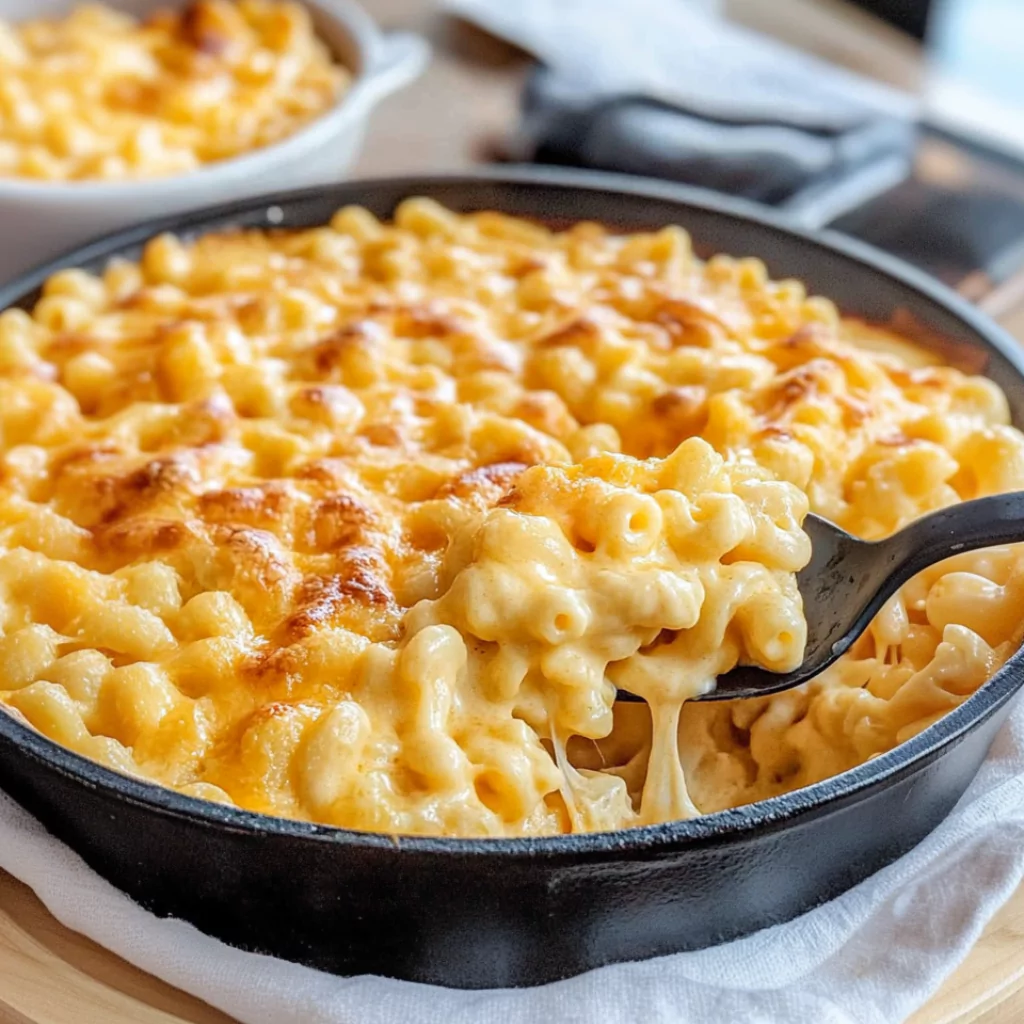
The beauty of baked mac and cheese lies in its simplicity, yet it offers endless opportunities for creativity. From classic recipes to gourmet variations with exotic cheeses and add-ins like lobster or bacon, this dish can adapt to suit any occasion. In this guide, we’ll walk you through the history, preparation, and secrets to making the ultimate baked mac and cheese at home.
Overview of Baked Mac and Cheese
Baked mac and cheese is more than just pasta mixed with cheese; it’s a carefully layered creation that combines texture and flavor. The process begins with al dente pasta, smothered in a rich and velvety cheese sauce made from a roux base. This mixture is then transferred to a baking dish, topped with breadcrumbs, and baked until golden and bubbling.
What sets baked mac and cheese apart from stovetop versions is the baking process. Baking not only enhances the dish’s flavors but also creates a crispy topping that contrasts beautifully with the creamy interior. While the classic recipe calls for elbow macaroni and cheddar cheese, modern interpretations often include a blend of cheeses like Gruyère, Parmesan, or mozzarella for added complexity.
Brief History and Cultural Significance
Macaroni and cheese has a rich history that dates back to the 14th century, with its earliest recorded recipe found in an Italian cookbook. Pasta layered with cheese and butter was an indulgence enjoyed by European nobility.
In the United States, the dish gained popularity thanks to Thomas Jefferson, who encountered macaroni during his travels to France and brought both the pasta and a macaroni-making machine back to America. The baked version we know today became a Southern staple, often served at family gatherings, Sunday dinners, and holiday celebrations. Over the years, baked mac and cheese evolved from a simple comfort food to a gourmet dish, with chefs experimenting with premium ingredients and unique toppings.
Preparation Phase and Tools to Use
Prep Time, Cook Time, Cool Time, and Yield
- Prep Time: Approximately 20 minutes
- Cook Time: 30–40 minutes
- Cool Time: 10 minutes
- Servings: 6–8
- Yield: About 8 cups of mac and cheese
Essential Tools and Equipment
- Baking Dish: Choose a 9×13-inch dish for even baking and serving.
- Large Pot: Necessary for boiling pasta.
- Whisk: Ideal for making a smooth roux and lump-free cheese sauce.
- Cheese Grater: Freshly grated cheese melts better than pre-shredded cheese.
- Measuring Cups and Spoons: Ensure accurate ingredient measurements.
- Spatula or Mixing Spoon: Helps fold the pasta into the cheese sauce evenly.
Importance of Each Tool
Each tool plays a crucial role in ensuring the dish’s success. For example, a whisk helps create a smooth roux, while a high-quality baking dish ensures even heat distribution. Using freshly grated cheese instead of pre-shredded varieties improves the sauce’s texture and taste, as pre-shredded cheese contains anti-caking agents that can affect melting.
Preparation Tips
- Choosing the Right Pasta
- Elbow macaroni is traditional, but shells, cavatappi, or penne work well. Their ridges and shapes help hold the cheese sauce.
- Selecting Cheeses
- Use a blend of cheeses for depth of flavor. Sharp cheddar provides the classic taste, while Gruyère adds nuttiness. Mozzarella or Monterey Jack can enhance creaminess, and Parmesan delivers a salty punch.
- Making a Perfect Roux
- A roux is a mixture of butter and flour cooked together, forming the base of the cheese sauce. Whisk constantly while cooking to prevent lumps.
- Seasoning for Balance
- Don’t rely solely on cheese for flavor. Add salt, pepper, Dijon mustard, and a pinch of nutmeg to enhance the sauce.
- Creating the Perfect Topping
- Mix panko breadcrumbs with melted butter for a crunchy topping. For extra flavor, sprinkle grated Parmesan or add a pinch of smoked paprika.
Ingredients List
- Pasta:
- 16 ounces elbow macaroni or preferred pasta shape.
- Cheeses:
- 2 cups sharp cheddar cheese, shredded.
- 1 cup Gruyère cheese, shredded.
- ½ cup Parmesan cheese, grated.
- For the Sauce:
- 4 tablespoons unsalted butter.
- 4 tablespoons all-purpose flour.
- 3 cups whole milk (or heavy cream for a richer sauce).
- 1 teaspoon Dijon mustard.
- Salt and pepper to taste.
- Topping:
- 1 cup breadcrumbs (panko preferred).
- 2 tablespoons melted butter.
- Optional: Fresh parsley or smoked paprika for garnish.
Step-by-Step Instructions
- Cook the Pasta
- Boil the pasta in salted water until al dente. Drain and set aside.
- Make the Roux
- In a large saucepan, melt butter over medium heat. Whisk in flour and cook for 1-2 minutes, stirring constantly.
- Add Milk
- Gradually pour in milk, whisking continuously to prevent lumps. Cook until the mixture thickens and coats the back of a spoon.
- Incorporate Cheese
- Remove the sauce from heat and stir in shredded cheeses one handful at a time until melted and smooth. Season with salt, pepper, and Dijon mustard.
- Combine Pasta and Sauce
- Fold the cooked pasta into the cheese sauce, ensuring every piece is coated.
- Assemble in a Baking Dish
- Transfer the pasta and cheese mixture to a greased baking dish.
- Prepare the Topping
- Mix breadcrumbs with melted butter. Sprinkle evenly over the pasta.
- Bake
- Bake in a preheated oven at 375°F (190°C) for 25–30 minutes, or until the topping is golden and crispy.
- Cool and Serve
- Let the dish cool for 10 minutes before serving.
Side Dish Recommendations
Baked mac and cheese is a versatile dish that pairs well with a wide variety of sides. Whether you’re preparing it as the centerpiece of a meal or a hearty side, these complementary dishes elevate its flavors while adding balance to the meal.
- Southern-Style Cornbread
The sweet and slightly crumbly texture of cornbread is a classic pairing with baked mac and cheese. Its light sweetness contrasts beautifully with the savory, cheesy pasta. For an added twist, include jalapeños or honey in the batter. - Garlic Butter Green Beans
Crisp-tender green beans coated in garlic butter add freshness and a hint of acidity that balances the richness of mac and cheese. They’re simple to prepare and bring a pop of color to the plate. - Creamy Coleslaw
The tangy, crunchy nature of coleslaw complements the creamy, cheesy texture of baked mac and cheese. Opt for a vinegar-based slaw for a lighter contrast or a creamy version for a classic pairing. - Roasted Brussels Sprouts
Roasted Brussels sprouts add a smoky, caramelized element to the meal. Toss them in olive oil, salt, and pepper, then roast until crispy on the edges. For extra flavor, sprinkle with Parmesan or drizzle with balsamic glaze. - Honey-Glazed Ham
The salty-sweet flavor of honey-glazed ham pairs exceptionally well with baked mac and cheese. Whether served on holidays or a casual weeknight, this duo always delivers a satisfying meal. - BBQ Pulled Pork
The smoky, savory flavors of pulled pork create a perfect harmony with the creamy mac and cheese. Add a drizzle of tangy barbecue sauce to enhance the flavor combination further. - Caesar Salad
A crisp Caesar salad with crunchy croutons and tangy dressing is a refreshing side that offsets the richness of baked mac and cheese. The sharpness of Parmesan cheese in the salad complements the dish’s cheesy notes. - Sweet Potato Casserole
For a truly indulgent pairing, serve baked mac and cheese alongside sweet potato casserole. The creamy sweet potatoes, crunchy pecan topping, and hint of sweetness create a unique yet harmonious combination.
Nutritional Information and Health Benefits
Baked mac and cheese is undoubtedly an indulgence, but understanding its nutritional profile can help you make it part of a balanced meal. Below, we’ll break down the key nutritional aspects and offer tips for lightening up the recipe.
- Calories and Macronutrients
A standard serving of baked mac and cheese provides approximately 400-450 calories. It’s rich in carbohydrates from the pasta, fats from butter and cheese, and protein from the dairy and cheese components. - Calcium and Vitamin D
One of the standout benefits of mac and cheese is its high calcium content, thanks to the cheese and milk. Calcium is essential for strong bones and teeth, while vitamin D helps the body absorb calcium effectively. - Energy Boost from Carbohydrates
The pasta in mac and cheese serves as a great source of energy, making it an ideal dish for busy days or active families. - Customizing for Health
While traditional recipes lean toward indulgence, there are several ways to make baked mac and cheese lighter:- Use whole-grain or legume-based pasta for added fiber and nutrients.
- Substitute lower-fat milk or use a mix of milk and chicken stock for the sauce.
- Reduce the butter and cheese portions slightly without compromising flavor.
- Add vegetables like spinach, broccoli, or peas to boost the nutritional content.
- Mindful Portions
Since baked mac and cheese is calorie-dense, serving it with lighter, vegetable-based sides helps create a well-balanced plate.
Common Mistakes and How to Perfect the Recipe
Even the simplest recipes can go awry without proper attention to detail. Below, we’ll address some of the most common mistakes made when preparing baked mac and cheese and how to avoid them.
- Overcooking or Undercooking the Pasta
- The Mistake: Cooking pasta until soft leads to mushy mac and cheese, while undercooked pasta results in an unpleasant texture.
- The Fix: Always cook the pasta to al dente. This ensures it retains its structure and texture even after baking.
- Using Pre-Shredded Cheese
- The Mistake: Pre-shredded cheese often contains anti-caking agents, which can affect the sauce’s smoothness.
- The Fix: Shred your cheese from blocks for a creamier and smoother cheese sauce.
- Skipping the Roux
- The Mistake: Avoiding the roux step can result in a watery or grainy cheese sauce.
- The Fix: Take time to make a roux by whisking butter and flour together. This step ensures a thick and velvety sauce.
- Not Seasoning the Sauce Properly
- The Mistake: Cheese alone may not provide enough flavor, leaving the dish bland.
- The Fix: Taste and adjust the seasoning with salt, pepper, Dijon mustard, and a touch of nutmeg for depth.
- Skipping the Topping
- The Mistake: Neglecting the breadcrumb topping can result in a one-dimensional dish.
- The Fix: Always add a crispy topping of buttered breadcrumbs, Parmesan, or crushed crackers for a contrast in texture.
- Overbaking the Dish
- The Mistake: Baking too long can cause the dish to dry out or the cheese to separate.
- The Fix: Bake only until the topping is golden and the cheese is bubbling, typically 25–30 minutes.
- Making the Sauce Too Early
- The Mistake: Preparing the sauce too far in advance can cause it to thicken or clump before use.
- The Fix: Make the sauce just before combining it with the pasta for the best results.
- Neglecting Variations
- The Mistake: Sticking to a basic recipe might feel repetitive over time.
- The Fix: Experiment with add-ins like cooked bacon, caramelized onions, or fresh herbs for variety.
Tips for Perfect Baked Mac and Cheese
Even small adjustments can make a huge difference in the quality of your baked mac and cheese. Here are some tried-and-true tips to help you perfect your dish every time:
- Use Fresh Ingredients
- Always opt for fresh blocks of cheese and shred them yourself. Pre-shredded cheese contains additives that can interfere with melting and texture.
- Season in Layers
- Season every component of the dish—boiling water for the pasta, the cheese sauce, and even the topping. This ensures every bite is flavorful.
- Mix Cheese Varieties
- Combining cheeses like sharp cheddar, Gruyère, and Parmesan creates a complex, rich flavor. Experiment with other cheeses like Monterey Jack, fontina, or smoked gouda for unique variations.
- Add a Textural Element
- Don’t skip the topping! A layer of buttered breadcrumbs, crushed crackers, or grated Parmesan adds crunch and enhances the dish’s overall texture.
- Let it Rest Before Serving
- After baking, allow the dish to rest for about 10 minutes. This helps the cheese sauce thicken slightly and ensures the flavors settle.
- Customize the Recipe
- Add-ins like cooked bacon, caramelized onions, roasted vegetables, or even lobster can transform this dish into something extraordinary.
Notes on Variations and Customizations
Baked mac and cheese is a blank canvas for culinary creativity. Here are some popular variations to try:
- Gourmet Mac and Cheese
- Use luxurious ingredients like truffle oil, lobster, or smoked salmon to elevate the dish into a gourmet masterpiece.
- Vegetable-Loaded Mac and Cheese
- Stir in roasted vegetables like broccoli, cauliflower, or butternut squash for added texture, flavor, and nutritional value.
- Spicy Mac and Cheese
- Add heat with ingredients like diced jalapeños, crushed red pepper flakes, or a dash of hot sauce. Pepper Jack cheese works well in this variation.
- Gluten-Free Mac and Cheese
- Substitute gluten-free pasta and use a gluten-free flour or cornstarch to make the roux.
- Vegan Mac and Cheese
- Swap dairy-based ingredients for plant-based alternatives like cashew cream, almond milk, and vegan cheeses.
Storing and Reheating Baked Mac and Cheese
- Storing Leftovers
- Allow the mac and cheese to cool completely before storing. Transfer leftovers to an airtight container and refrigerate for up to 4 days.
- Freezing Mac and Cheese
- Baked mac and cheese can be frozen for up to 2 months. To freeze, wrap the baking dish tightly in plastic wrap and aluminum foil or portion it into freezer-safe containers.
- Reheating Instructions
- For best results, reheat in the oven at 350°F (175°C) until heated through. To prevent dryness, add a splash of milk or cream before reheating. Alternatively, reheat smaller portions on the stovetop over low heat, stirring in a little milk to restore creaminess.
Frequently Asked Questions (FAQs)
1. Can I make baked mac and cheese ahead of time?
Yes, you can prepare the mac and cheese up to the point of baking, then cover and refrigerate it for up to 24 hours. When ready to bake, let it sit at room temperature for 20 minutes before placing it in the oven.
2. What are the best cheeses to use for baked mac and cheese?
Sharp cheddar is a classic choice, but combining it with Gruyère, Parmesan, or mozzarella enhances flavor and creaminess. Experiment with other cheeses like smoked gouda or fontina for unique variations.
3. Can I freeze baked mac and cheese?
Absolutely! Allow the dish to cool completely, then wrap it tightly or transfer it to a freezer-safe container. Freeze for up to 2 months. Reheat in the oven to restore its texture and flavor.
4. How do I prevent my cheese sauce from becoming grainy?
Grainy sauce usually results from overheating the cheese. Always remove the sauce from heat before adding the cheese and stir it in gradually to ensure a smooth consistency.
5. Is it possible to make baked mac and cheese gluten-free?
Yes! Use gluten-free pasta and substitute the all-purpose flour in the roux with a gluten-free alternative, such as rice flour or a cornstarch slurry.
6. How do I make the topping extra crispy?
For a crispier topping, use panko breadcrumbs mixed with melted butter. You can also broil the dish for the last 2–3 minutes of baking to achieve a golden, crunchy finish.
7. Why is my baked mac and cheese dry?
Overbaking is the most common cause of dryness. Ensure you bake it just until the topping is golden and the cheese is bubbling. Adding a splash of milk or cream to the pasta before baking can also help keep it moist.
8. Can I use plant-based ingredients to make vegan mac and cheese?
Yes, many plant-based options are available, such as cashew cream, almond milk, and nutritional yeast. Vegan cheeses like cashew cheddar or coconut-based cheese substitutes can create a creamy, flavorful dish.
Conclusion
Baked mac and cheese is the ultimate comfort food, offering a satisfying blend of creamy cheese sauce, tender pasta, and a crispy golden topping. Its versatility allows for endless customizations, making it a dish that suits casual weeknight dinners and festive gatherings alike.
Whether you stick to the classic recipe or explore creative variations, baked mac and cheese is a guaranteed crowd-pleaser. With the tips, techniques, and insights shared in this guide, you can confidently create a dish that’s rich, flavorful, and utterly indulgent. Get ready to impress family and friends with a baked mac and cheese that’s truly unforgettable!
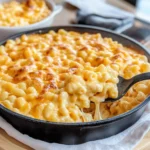
Baked Mac And Cheese
- Total Time: 50 minutes
- Yield: 8 servings 1x
Description
Creamy and cheesy baked mac and cheese topped with crispy golden breadcrumbs. Perfect for family dinners, potlucks, or holidays, this classic comfort dish is a guaranteed hit.
Ingredients
- Pasta: 16 oz elbow macaroni
- Cheeses:
- 2 cups sharp cheddar cheese, shredded
- 1 cup Gruyère cheese, shredded
- ½ cup Parmesan cheese, grated
- Sauce:
- 4 tbsp unsalted butter
- 4 tbsp all-purpose flour
- 3 cups whole milk
- 1 tsp Dijon mustard
- Salt and pepper to taste
- Topping:
- 1 cup breadcrumbs (panko preferred)
- 2 tbsp melted butter
- Optional: Smoked paprika or parsley for garnish
Instructions
- Preheat oven to 375°F (190°C).
- Cook pasta in salted water until al dente. Drain and set aside.
- Melt butter in a large saucepan over medium heat. Whisk in flour and cook for 1-2 minutes.
- Gradually add milk, whisking until thickened. Remove from heat.
- Stir in shredded cheeses, Dijon mustard, salt, and pepper until smooth.
- Combine the cooked pasta with the cheese sauce. Mix well.
- Transfer to a greased baking dish and spread evenly.
- Mix breadcrumbs with melted butter and sprinkle over the top.
- Bake for 25–30 minutes, until golden and bubbly.
- Let cool for 10 minutes before serving.
- Prep Time: 20 minutes
- Cook Time: 30 minutes
- Category: Main Dish
- Method: Baking
- Cuisine: American
Nutrition
- Calories: 420
- Sugar: 4g
- Sodium: 480mg
- Fat: 22g
- Saturated Fat: 12g
- Unsaturated Fat: 8g
- Carbohydrates: 40g
- Fiber: 2g
- Protein: 16g
- Cholesterol: 55mg

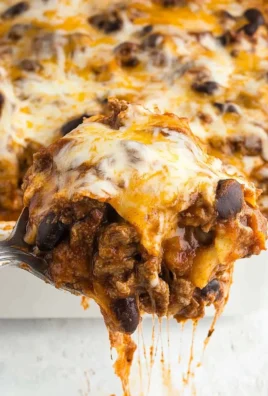
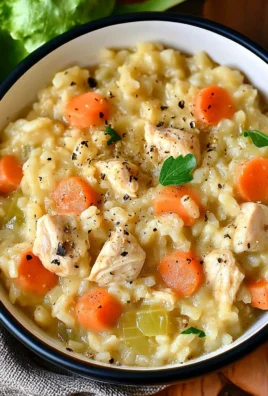
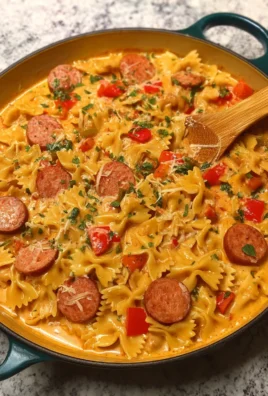
Leave a Comment